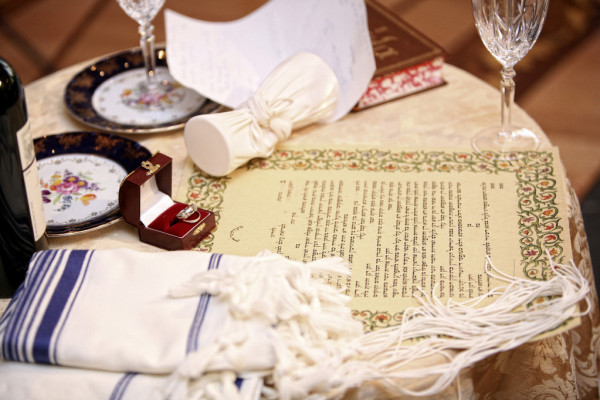In traditional Judaism, marriage is viewed as a contractual bond commanded by God in which a man and a woman come together to create a relationship in which God is directly involved. Though procreation is not the sole purpose, a Jewish marriage is traditionally expected to fulfil the commandment to have children. (Gen. 1:28) In this view, marriage is understood to mean that the husband and wife are merging into a single soul, which is why a man is considered “incomplete” if he is not married, as his soul is only one part of a larger whole that remains to be unified.
In Jewish law, an engagement (kiddushin) is a contract between a man and a woman where they mutually promise to marry each other, and the terms on which it shall take place.The promise may be made by the intending parties or by their respective parents or other relatives on their behalf. The promise is formalized in a document known as the Shtar Tena’im, the “Document of Conditions”, which is read prior to the badekin. After the reading, the mothers of the future bride and groom break a plate. Today, some sign the contract on the day of the wedding, some do it as an earlier ceremony, and some do not do it at all.
Marriage obligations and rights in Judaism are ultimately based on those apparent in the Bible, which have been clarified, defined, and expanded on by many prominent rabbinic authorities throughout history.
Citing the primacy of the divine command given in Genesis 1:28, the time between puberty and age twenty has been considered the ideal time for men and women to be wed in traditional Jewish thought. Some rabbis have gone further to commend the age of eighteen as most ideal, while others have advocated for the time immediately following puberty, closer to the age of fourteen, essentially “as early in life as possible.” Babylonian rabbis understood marriage as God’s means of keeping male sexuality from going out of control, so they advocated for early marriage to prevent men from succumbing to temptation in their youth.[66] Some commended early marriage for its benefits: Rabbi Ḥisda maintained that early marriage could lead to increased intelligence.
According to the Talmud, a father is commanded not to marry his daughter to anyone until she grows up and says, “I want this one”. A marriage that takes place without the consent of the girl is not an effective legal marriage.
While wedding ceremonies vary, common features of a Jewish wedding include a ketubah (marriage contract) which is signed by two witnesses, a chuppah (or huppah; wedding canopy), a ring owned by the groom that is given to the bride under the canopy, and the breaking of a glass.
Technically, the Jewish wedding process has two distinct stages: kiddushin (sanctification or dedication, also called erusin, betrothal in Hebrew) and nissuin (marriage), when the couple start their life together. The first stage prohibits the woman to all other men, requiring a get (religious divorce) to dissolve, and the final stage permits the couple to each other. The ceremony that accomplishes nissuin is known as chuppah.
Today, erusin/kiddushin occurs when the groom gives the bride a ring or other object of value with the intent of creating a marriage. There are differing opinions as to which part of the ceremony constitutes nissuin/chuppah; they include standing under the canopy – itself called a chuppah – and being alone together in a room (yichud). While historically these two events could take place as much as a year apart,they are now commonly combined into one ceremony.
